Hunting and Fishing
Click on pictures for larger image
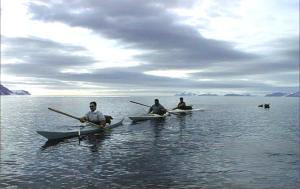 Qaanaaq is in the high Arctic. Species of animals, fish and birds are very
few compared to other parts of the world. Most of the land is covered
by ice caps or very slow flowing glaciers. Sea is normally covered
by ice from end of October until mid July. Cracks in the sea-ice
and areas with open sea occur all year round depending on weather and
tide.
Qaanaaq is in the high Arctic. Species of animals, fish and birds are very
few compared to other parts of the world. Most of the land is covered
by ice caps or very slow flowing glaciers. Sea is normally covered
by ice from end of October until mid July. Cracks in the sea-ice
and areas with open sea occur all year round depending on weather and
tide.
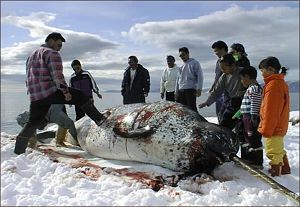 The narwhale is a very attractive prey to the hunter. It provides him with a
lot of meat and the thick skin - called mattaq. Mattaq is very
tasty and delicious when one is used to it, and besides it is very rich in
vitamins. An adult male narwhale sometimes has a tusk up to 9 feet long
(about 3 meters). Most tusks from narwhales are used for carving
beautiful handicrafts - unfortunately international restrictions
concerning ivory forbids export of these items to most countries.
The narwhale is a very attractive prey to the hunter. It provides him with a
lot of meat and the thick skin - called mattaq. Mattaq is very
tasty and delicious when one is used to it, and besides it is very rich in
vitamins. An adult male narwhale sometimes has a tusk up to 9 feet long
(about 3 meters). Most tusks from narwhales are used for carving
beautiful handicrafts - unfortunately international restrictions
concerning ivory forbids export of these items to most countries.
During winter and spring the narwhale is a regular at the ice edge
or in cracks in the sea ice. In the open water season it is seen very
often even in the inner parts of fiords and inlets. Narwhale
hunting is practiced only in the traditional way by hunters harpooning the
whales from small kayaks. According to old rules the whale is split up in
parts between hunters in the party.
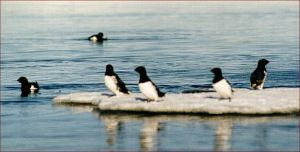 One of the most abundant and valuable birds in the area is the Dovekie (alle alle), known here as "auk". The very tiny auk nests by the millions on the cliffs. For
hundreds of years the small bird has been a major factor for man surviving.
In the spring the auk is caught with small hand held nets (like a kind of
catcher). Several hundred will be stuffed into a sealskin with some
blubber (fat) left on it. The bag is stored away in a cool place to marinate. Several months later the marinated auks can be eaten. The consistency and taste are
of course special, but like all Inuit food, it is extremely tasty once a person gets used
to it. Until a few years ago the skin of the birds was
used for making clothes - especially for soft and warm underwear for small
children.
One of the most abundant and valuable birds in the area is the Dovekie (alle alle), known here as "auk". The very tiny auk nests by the millions on the cliffs. For
hundreds of years the small bird has been a major factor for man surviving.
In the spring the auk is caught with small hand held nets (like a kind of
catcher). Several hundred will be stuffed into a sealskin with some
blubber (fat) left on it. The bag is stored away in a cool place to marinate. Several months later the marinated auks can be eaten. The consistency and taste are
of course special, but like all Inuit food, it is extremely tasty once a person gets used
to it. Until a few years ago the skin of the birds was
used for making clothes - especially for soft and warm underwear for small
children.
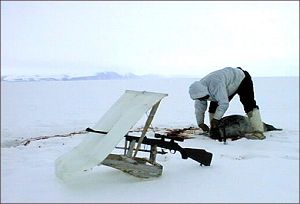 In spring, when the weather gets warmer, the seals crawl up through
their breathing holes just to lie on the ice. This happens while they
change their pelts (hair). Often they stay on the ice for many hours. It
looks like they sleep but about every 10 seconds they raise their heads
to have a quick look around for enemies. In the season many hunters
practice hunting the seals on the ice. Behind a white "sail" attached to a
small sledge, the hunter sneaks into shooting distance of the
seal. With a trained dog team, the dogs will wait patiently and
quietly.
They will not follow the hunter until the rifle is fired or the hunter
calls for them.
In spring, when the weather gets warmer, the seals crawl up through
their breathing holes just to lie on the ice. This happens while they
change their pelts (hair). Often they stay on the ice for many hours. It
looks like they sleep but about every 10 seconds they raise their heads
to have a quick look around for enemies. In the season many hunters
practice hunting the seals on the ice. Behind a white "sail" attached to a
small sledge, the hunter sneaks into shooting distance of the
seal. With a trained dog team, the dogs will wait patiently and
quietly.
They will not follow the hunter until the rifle is fired or the hunter
calls for them.
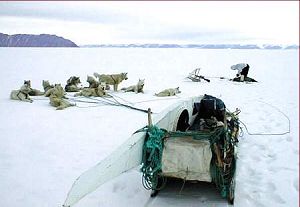 The hunter and his dogs have been the key to success to almost all important high arctic expeditions during the years. Through many generations
the hunter has built up unique knowledge and experience about surviving
in the arctic. Of no less importance were the hunter's women.
Often participating in the expeditions, they provided clothing more
comfortable and warm than any artificially made product brought by the explorers.
The hunter and his dogs have been the key to success to almost all important high arctic expeditions during the years. Through many generations
the hunter has built up unique knowledge and experience about surviving
in the arctic. Of no less importance were the hunter's women.
Often participating in the expeditions, they provided clothing more
comfortable and warm than any artificially made product brought by the explorers.
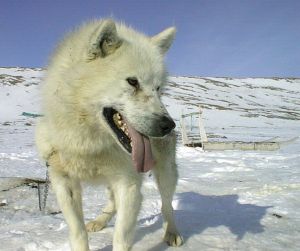 Half wolf and half dog - the Greenland husky is a quite unique
animal.
It is a perfect combination for the high arctic climate. It is strong,
very intelligent,and has high endurance for work in the harshest weather on earth. The Greenland dog always has been important to the polar Eskimo
as a means of travel in conditions where modern machines routinely fail.
Half wolf and half dog - the Greenland husky is a quite unique
animal.
It is a perfect combination for the high arctic climate. It is strong,
very intelligent,and has high endurance for work in the harshest weather on earth. The Greenland dog always has been important to the polar Eskimo
as a means of travel in conditions where modern machines routinely fail.
The dogsledge is still by far the most common means of
transportation today.
Snowscooters can be used but are not allowed due to a wish to protect
the culture and invironment.
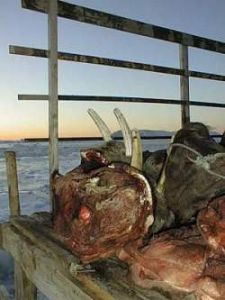 The walrus is an important game and is mostly hunted in the area
south and west of the settlement Siorapaluk. The hunt is going on
almost at any time of the year by boat or with dogsledge. In winter
the walrus is harpooned in areas with thinner ice when the walrus breaks through
the ice to breathe.
The walrus is an important game and is mostly hunted in the area
south and west of the settlement Siorapaluk. The hunt is going on
almost at any time of the year by boat or with dogsledge. In winter
the walrus is harpooned in areas with thinner ice when the walrus breaks through
the ice to breathe.
During the long and dark winter, unstable weather can make
hunting impossible or extreemly difficult and sometimes resultless for
long periods. Walrus hunting is very important in the fall because it is the best dog food. The meat from
the walrus is propably the best dogfood one can get because it is only slowly
processed in the dog´s stomach. An adult walrus weighs
several hundred kilos and the boiled meat is very tasty for the Inuit also. Most of the
walrus
caught have tusks. These tusks and the skulls are mostly used for local
production of handicrafts.
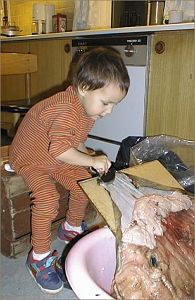 Most common prey all year round is the seal. In the district of
Qaanaaq - as in the rest of Greenland - there are no "baby-seals"
caught. However, the adult seal meat is eaten by man boiled, roasted, or raw frozen. The rest
is for feeding the dogs. The skins are mostly used for
making clothing like boots (kamiks), mits, anoraqs or
handicrafts.
Some are exported for fur-making in Greenland or other countries.
Unfortunately many countries still have restrictions against importing
fur from the seals. This of course causes low prices for the Inuit hunters.
This is not an easy situation if you have no real other opportunity for income
and still want to keep your dignity intact!
Most common prey all year round is the seal. In the district of
Qaanaaq - as in the rest of Greenland - there are no "baby-seals"
caught. However, the adult seal meat is eaten by man boiled, roasted, or raw frozen. The rest
is for feeding the dogs. The skins are mostly used for
making clothing like boots (kamiks), mits, anoraqs or
handicrafts.
Some are exported for fur-making in Greenland or other countries.
Unfortunately many countries still have restrictions against importing
fur from the seals. This of course causes low prices for the Inuit hunters.
This is not an easy situation if you have no real other opportunity for income
and still want to keep your dignity intact!
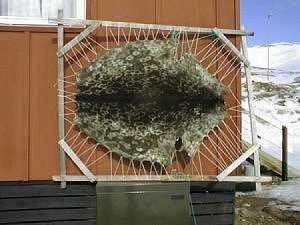 Preparing seal skins for traditional clothing is womens job. The treatment takes time and a lot of ekspertice is needed. Depending on the purpose, the time used and treatment differs in many ways. But it is allways hard work.
Preparing seal skins for traditional clothing is womens job. The treatment takes time and a lot of ekspertice is needed. Depending on the purpose, the time used and treatment differs in many ways. But it is allways hard work.
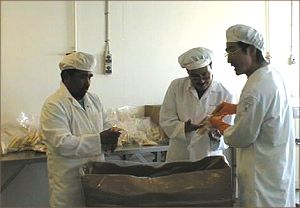 The Royal Greenland Company has in the district two minor departments
for handling and producing local products. The most common
products are from narwhale, seal, arctic halibut and auks.
The Royal Greenland Company has in the district two minor departments
for handling and producing local products. The most common
products are from narwhale, seal, arctic halibut and auks.
The average production is small measured on an economic
scale. However many family's wealth is based on a high grade of "selfproviding"
and as such, hunting and fishing still have a significant influence on the
private economy.
It is expected - like it has happened in other parts of Greenland
- that halibut fishing will be developed and give a better average
income for hunters.

Back to Directory
Counter for statistical purposes and may be reset: 
 Qaanaaq is in the high Arctic. Species of animals, fish and birds are very
few compared to other parts of the world. Most of the land is covered
by ice caps or very slow flowing glaciers. Sea is normally covered
by ice from end of October until mid July. Cracks in the sea-ice
and areas with open sea occur all year round depending on weather and
tide.
Qaanaaq is in the high Arctic. Species of animals, fish and birds are very
few compared to other parts of the world. Most of the land is covered
by ice caps or very slow flowing glaciers. Sea is normally covered
by ice from end of October until mid July. Cracks in the sea-ice
and areas with open sea occur all year round depending on weather and
tide.








